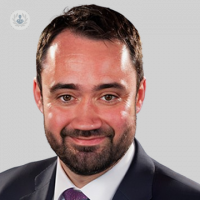A guide to gallbladder disease
Escrito por:The gallbladder is a small, pear-shaped sac that is located under the liver that stores the bile produced by the liver. Sometimes it can get inflamed, infected, or form gallstones which can cause painful obstructions. In this article, a consultant upper gastrointestinal surgeon explains the characteristics of gallbladder diseases and how they can be treated.

What is the gallbladder?
The gallbladder’s purpose in the body is to use the bile it collects and concentrates to break down cholesterol and similar substances for the digestive system. When we start eating, the gallbladder starts secreting the bile into the small intestine where it mixes with the food waiting to be digested.
What are the types of gallbladder diseases?
- When there’s too much cholesterol for the gallbladder to process, this can cause gallstones, which are small structures resembling pebbles that form in the gallbladder. They are usually harmless and can pass through the body without issues, but sometimes they are too big and cause pain. Gallstones left untreated can cause scarring, gangrene, and perforation.
- Cholecystitis happens when gallstones get stuck in the bile ducts, causing inflammation, pain, fever, and possibly infection. Typically, it is treated by surgery.
- Gallstone pancreatitis, which happens when a gallstone has made it out of the gallbladder but gets stuck at the pancreatic duct, just before the small intestine.
- Gallbladder cancer, where there are abnormal cells in the gallbladder, causing tumours.
- Biliary dyskinesia, where the gallbladder, due to a muscle or nerve issue, cannot move bile into the bile ducts as it should, causing similar symptoms to a gallstone blockage.
What causes gallbladder disease?
Gallbladder diseases are mostly likely to affect people who are older than 60 years old, but the diet has a significant influence on the likelihood of contracting a gallbladder disease as well.
Those who are overweight or overeat are more susceptible, due to the introduction of excess cholesterol that the body is unable to process. Diets that have a lot of fatty meats, butter and lard, creams, and palm or coconut oil can contribute to this.
Other conditions that can lead to gallbladder disease include Crohn’s disease, due to the reduced ability to absorb bile salts; liver cirrhosis, which is when the liver is heavily scarred and cannot function as it should; diabetes, as it causes higher levels of fatty acids; and sickle cell disease, which causes a build-up of bilirubin in the gallbladder (another substance which can form gallstones).
How are gallbladder diseases treated?
When gallbladder diseases go untreated and the gallbladder cannot function as normal, the bile from it doesn’t go to the small intestines to aid with digestion, making digestion difficult. The bile also builds up in the blood, along with the toxins within it, causing illness and pain.
In the case of an infection, doctors will prescribe antibiotics to treat the gallbladder. Minor issues can be addressed with laparoscopic procedures, like gallstone removal and opening up the bile ducts if they have fused shut. This involves a surgeon making small incisions in the abdomen around the belly button. Using instruments and the long, thin camera called a laparoscope, they will access the organs via the incisions to treat the gallbladder. The incisions are sealed with sutures, surgical staples, or surgical tape and dressed.
In extreme and persistent cases of gallbladder disease, then surgery, called cholecystectomy, will be considered to remove the gallbladder entirely. It is not strictly a necessary organ, as the bile it stores is actually made in the liver, so bodily function should still be normal. It can be performed openly or laparoscopically, which is more common. Laparoscopy is preferred because it is minimally invasive, which means less blood loss and a shorter recovery time for the patient.
If you are having abdominal pain and believe you are suffering from gallstone issues, you can consult with a specialist via Top Doctors.


